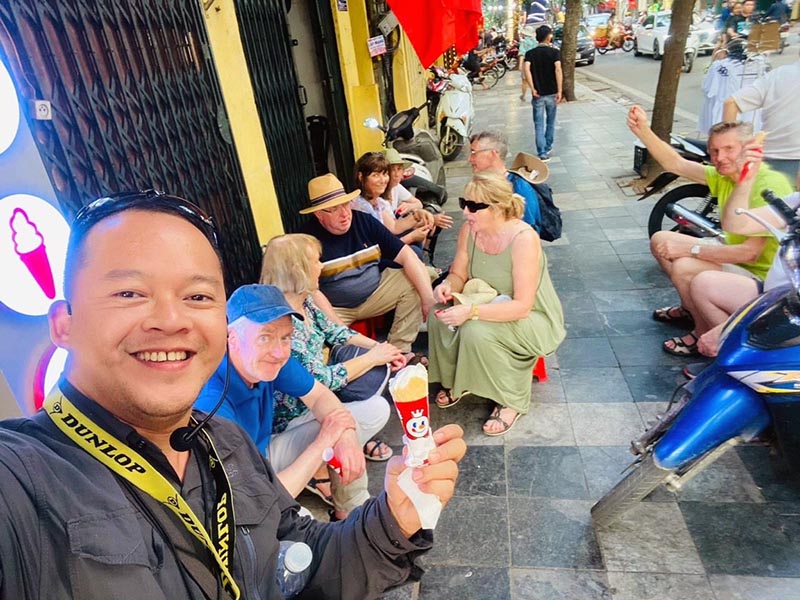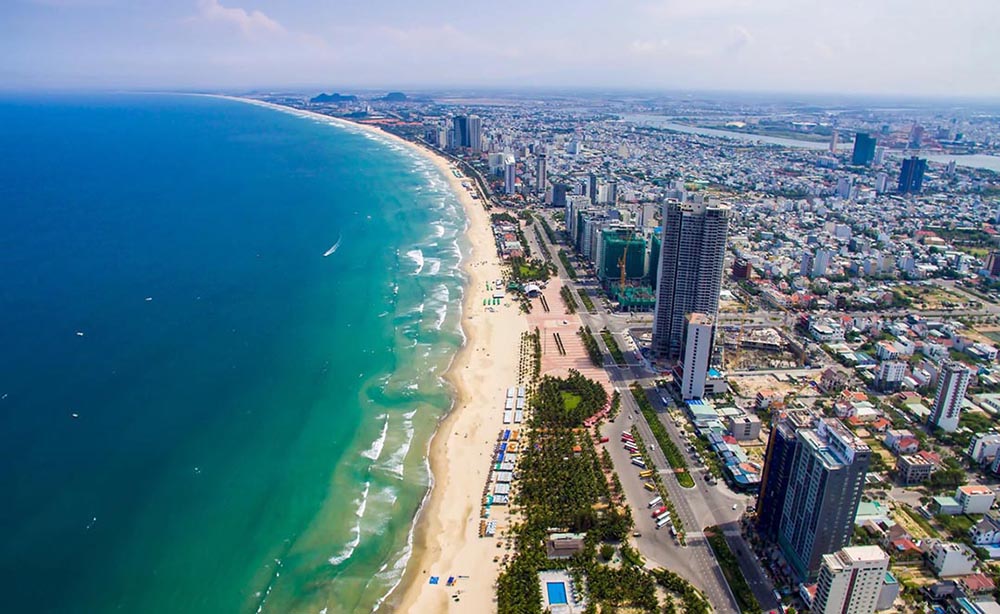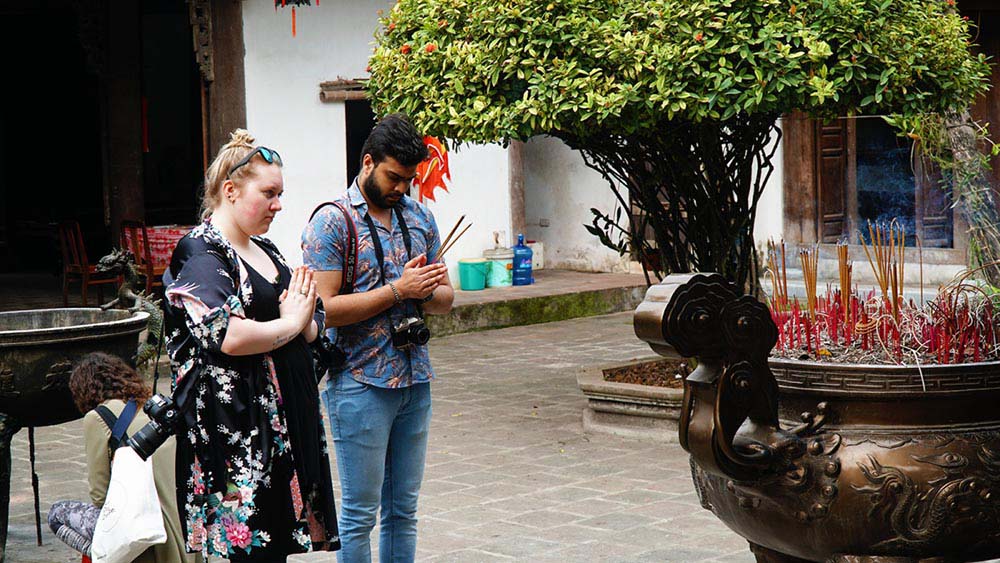Why visiting temples in Vietnam is a must-do for travelers
-
Religious beliefs are a part of Vietnam’s culture: Since its inception, religion and belief have established, shaped and preserved many spiritual, moral values and traditional arts of the Vietnamese people. It has also helped to generate various handicraft and art occupations for producing and crafting religious products such as making wooden and stone statues, incense, paper money and constructing temples.
-
Reflecting the history and architecture: Vietnam temple offers a glimpse into the country's memories through different periods and regions. They are attractive with ancient architecture and beautiful surroundings. From the intricate carvings and mosaics to the tranquil gardens and courtyards, visiting the Vietnam temple is a great way to enjoy the construction in a sacred and scenic space.
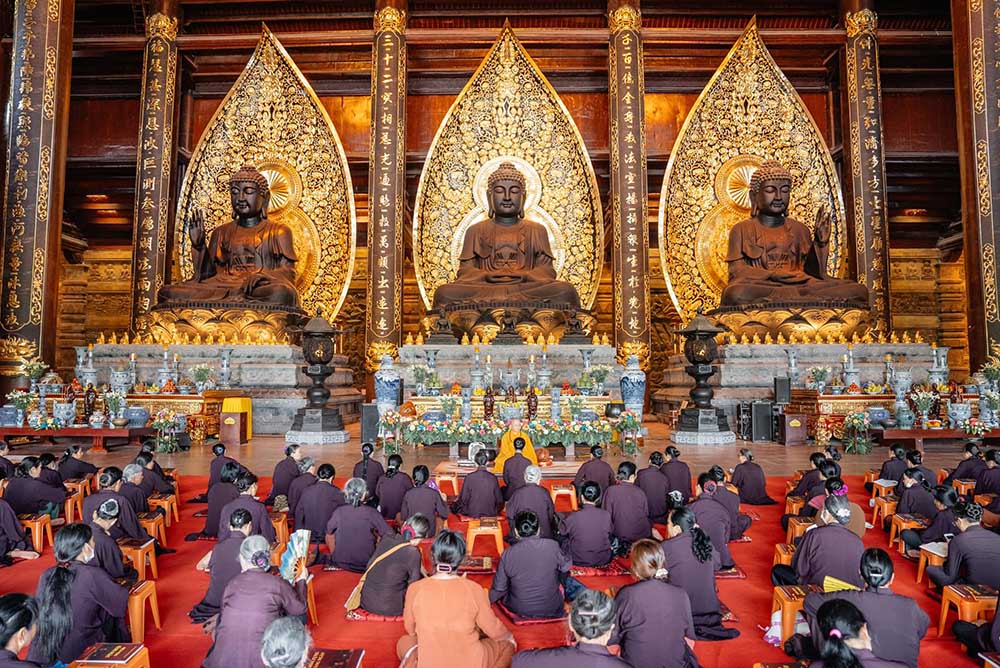
-
Connect with Vietnamese spiritual life: Temples and pagodas are places that honor the values of humanity and morality that Vietnamese people hold in high regard. They are places where communities practice their religious beliefs. By visiting the Vietnam temple, you will gain a greater understanding of Vietnam culture and people.
-
Bring you a local touch: Visiting pagodas and temples, admiring the architecture and scenery, learning about the destination and observing religious activities such as praying, meditating, worshiping and performing rituals, you have participated and immersed yourself in the cultural and religious space of Vietnamese people.
Top 9 spiritual Temples and Pagodas in Vietnam
Here is our list of 9 prominent and iconic temples and pagodas in Vietnam that we recommend you visit. Let’s take a look and see how the Vietnam temple can make your trip more insightful.
Temple of Literature in Hanoi
The Temple of Literature is widely known for being Vietnam’s first university. This ancient Vietnam temple was founded in 1070 and served as the capital educational center and a Confucian temple.

Khue Van Pavilion - the symbol appears in Vietnam’s 100,000 VND banknote
-
Whereabouts: Hanoi - 58 Quoc Tu Giam Street, Van Mieu Ward, Dong Da District
-
Opening time: From 8 AM to 5 PM (Monday - Sunday)
-
Entrance fee:
-
Adults: 30,000 VND (about 1,3 USD) for adults
-
Children under 15 years old: Free
Some activities that often occur here include exhibitions, workshops and ceremonies related to Vietnam’s traditional culture, art, and education. Visit the Temple of Literature, you can admire the Van Lake, Great Gate, Khue Van Pavilion, Thien Quang Well, Doctor's Stone Steles, Stone Turtles, Hall of Great Accomplishments, House of Ceremonies, Altars, etc.
One Pillar Pagoda in Hanoi
One Pillar Pagoda is an iconic Buddhist pagoda of Vietnam due to its unique structure. It is built on a single pillar which is inspired by a lotus flower. The Vietnam temple is located in a serene and peaceful garden setting, with plenty of greenery and ponds that make it a beautiful spot for photography and relaxation.
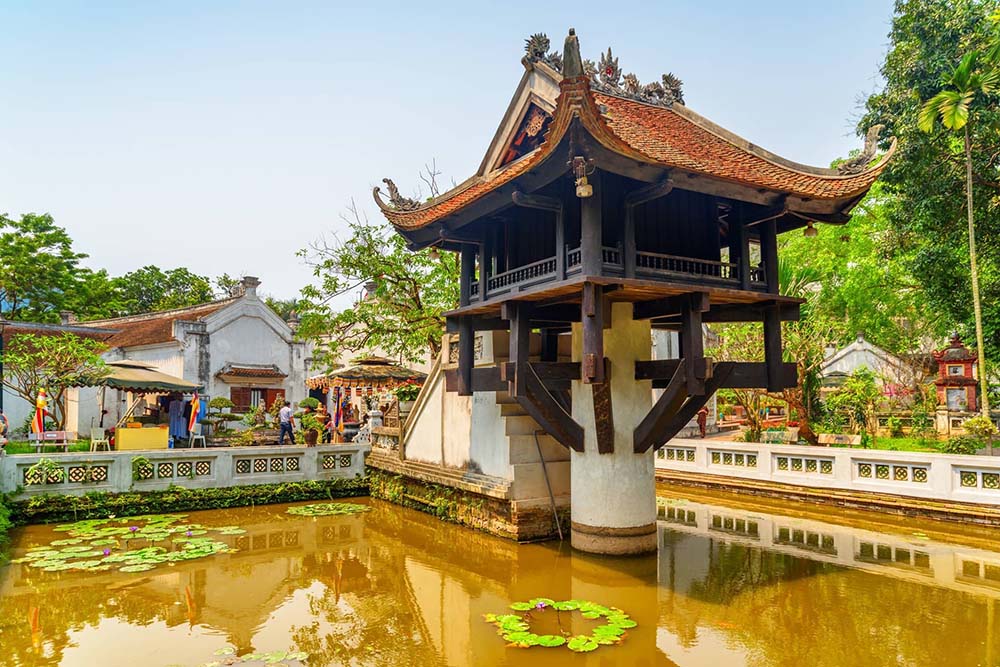
The pagoda with just one pillar
-
Whereabouts: Hanoi - Ong Ich Khiem Street, Ngoc Ha Ward, Ba Dinh District
-
Opening hours: 7 AM - 6 PM from Monday to Sunday
-
Entrance fee: Free
The One Pillar Pagoda originated from a dream of King Ly Thai Tong in 1049, making it one of Vietnam's oldest temples. In the dream, the Goddess of Mercy appeared and gifted him a shining lotus blossom. The Vietnam temple was initially chosen by the King to perform rituals to request national peace and prosperity. Nowadays, people still maintain their spiritual beliefs, visiting the One Pillar Pagoda to pray and seek inner peace.
Actually, the original pagoda was destroyed by the French colonizers before they withdrew from Hanoi in 1954. The current pagoda has been reconstructed by the Vietnamese government, preserving the old architectural design and features. The One Pillar Pagoda is located in a park adjacent to Ba Dinh Square and Ho Chi Minh Complex, making it convenient for visitors to stop by.
Huong Pagoda in Hanoi
Huong Pagoda is one of the most important religious sites in Vietnam with a history dating back to the 15th century, also one of the largest Buddhist temples in Vietnam. It is actually a complex of small pagodas embodied in splendid caves and the rocks of the Huong Tich limestone mountain providing amazing views of the landscape while visiting.
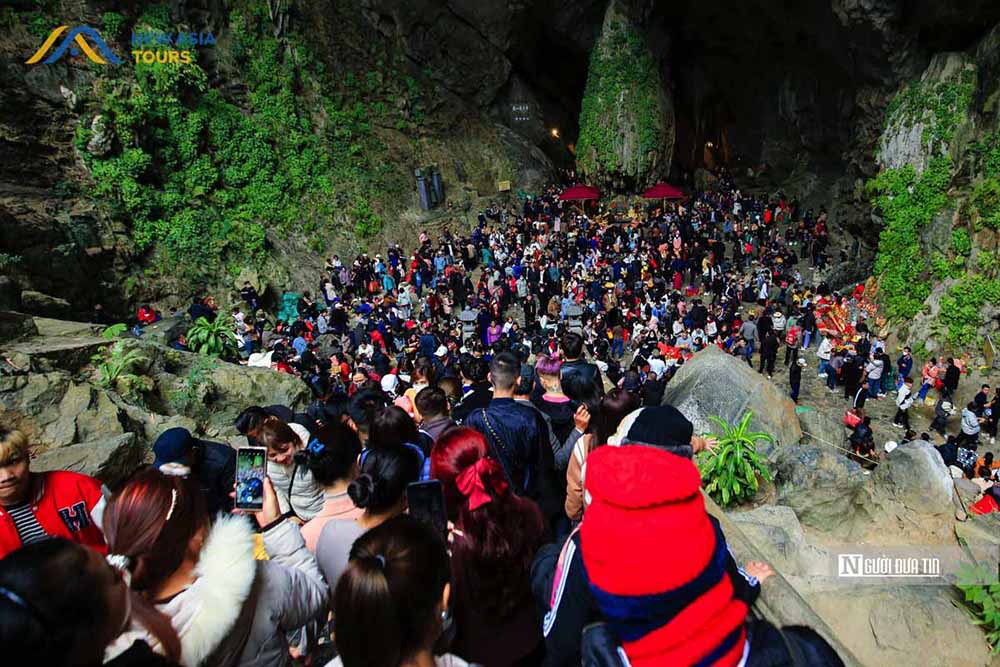
The sacred pagoda hiding in a cave
-
Whereabouts: Hanoi - Wharf Yen, Huong Son Commune, My Duc District
-
Opening time: All days and times in the week
-
Fees:
-
Entrance fee: 80,000 VND/pax (about 3,4 USD) for adults, free for children under 1 meter and 6 years old.
-
Boat fee: 50,000 VND/pax (about 2,1 USD) for the main route and 35,000 VND/pax ( about 1,5 USD) for side routes.
-
Cable car (if you choose): 1-way ticket - 120,000 VND (about 5 USD), round trip 180,000 VND (about 7,7 USD).
Huong Pagoda Festival is considered Vietnam’s longest and most elaborate annual festival. The festival, which lasts for the first three months of the Lunar new year, is held annually and attracts a large number of Buddhist pilgrims who come to offer incense, prayers for good fortune and release their souls to merge with nature in a region steeped in Buddhist tales and spiritual culture.
Tam Chuc Pagoda in Ha Nam
The Tam Chuc Temple complex is an impressive spiritual site spanning over 5,100 hectares, featuring stunning architecture, nature, and a rich history. The Vietnam temple is regarded as the largest Buddhist temple in Vietnam and is currently the largest pagoda complex of Southeast Asia. Tam Chuc was reportedly constructed in the 13th century and has undergone several renovations to achieve its grand appearance as seen today.
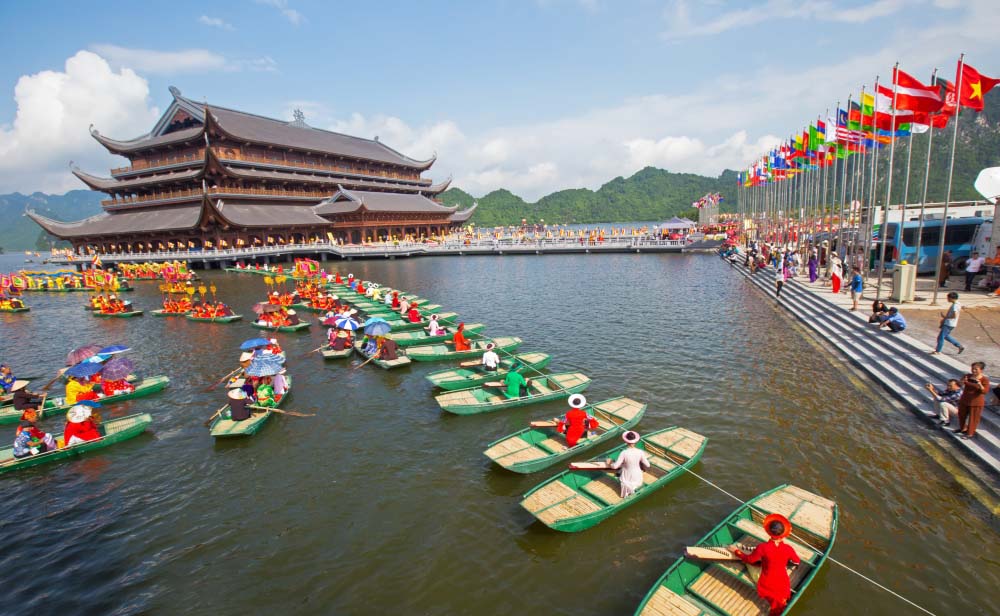
Tam Chuc - The largest pagoda complex of Southeast Asia
-
Whereabouts: Hanam - Ba Sao Town, Kim Bang District
-
Opening time: From 6 AM to 8 PM (Monday - Sunday)
-
Fees:
-
Entrance fee: Free
-
Electric car (if you choose): 90,000 VND/pax/round trip (about 3,8 USD)
-
Boat fee (if you choose): 200,000 VND/pax/round trip (about 8,5 USD) for normal boat and 240,000 VND/pax for VIP boat/round trip (about 10 USD)
Visitors can choose to ride an electric car or take a boat to save time walking around the vast complex of Tam Chuc Pagoda. If you choose the boat, you can enjoy the view of small islets.
What to see in this Vietnam temple: Thuy Dinh Guest House, Tam Quan Gate, Column Garden, Three main Temples, Tam Chuc Hall, and Ngoc Temple Esplanade of Sacrifice to Heaven and Earth.
In addition to its beauty, Tam Chuc Pagoda attracts visitors with its annual festivals, which include parades, lantern decorations, and other traditional activities. Visitors can enjoy these celebrations and discover the colorful culture of Vietnam.
Yen Tu Pagoda in Quang Ninh
Yen Tu was chosen by King Tran Nhan Tong to practice Buddhism and later founded the Truc Lam Zen Monastery, which is a unique and impressive Vietnam temple located at an altitude of 1068m. The Vietnam temple constructed by large stone slabs encircles the base of the sturdy ironwood columns.

The peak 1068 m high of Yen Tu Pagoda and its breathtaking view
-
Whereabouts: Quang Ninh - Nam Mau village, Thuong Yen Cong Commune, Uong Bi District
-
Opening time: From 5 AM to 8 PM (Monday - Sunday)
-
Fees:
-
Entrance fee: 40,000 VND/adult (about 1,7 USD); 10,000 VND/children under 16 years old (about 0,43 USD) and free for children under 1,2m
-
Electric car (if you choose): 15,000 VND/pax/1 way - 20,000 VND/pax/round-trip (about 0,6 - 0,8 USD)
-
Cable car( if you choose): from 180,000 - 260,000 VND (about 7,8 - 11 USD). Free for children under 1,2m and elderly above 70 years old
Visitors who climb the mountain to visit this Vietnam Temple can also access to explore the Heaven Gate, the Buddhist big stele, the Yen Tu National Forest - a conservation area for numerous rare animal species and valuable genes and Truc Lam Yen Tu Zen Monastery - a tranquil location where many people choose to practice meditation and find peace.
Annually, the Yen Tu Pagoda Festival is organized at the beginning of the Lunar New Year and attracts many tourists to visit Quang Ninh province. The festival includes two main parts: the local people organize a ceremony at the base of the mountain, and then pilgrims will climb up to the peak where the Dong Pagoda is located.
Bai Dinh Pagoda in Ninh Binh
This ancient Vietnam temple was founded in the 11th century and has since been expanded and renovated several times. Bai Dinh is well known for its impressive size and grandeur, with a total area of over 500 hectares and more than 500 stone statues. Bai Dinh is among the top 2 largest Buddhist temples in Vietnam. The Vietnam temple also holds the most records in Vietnam.
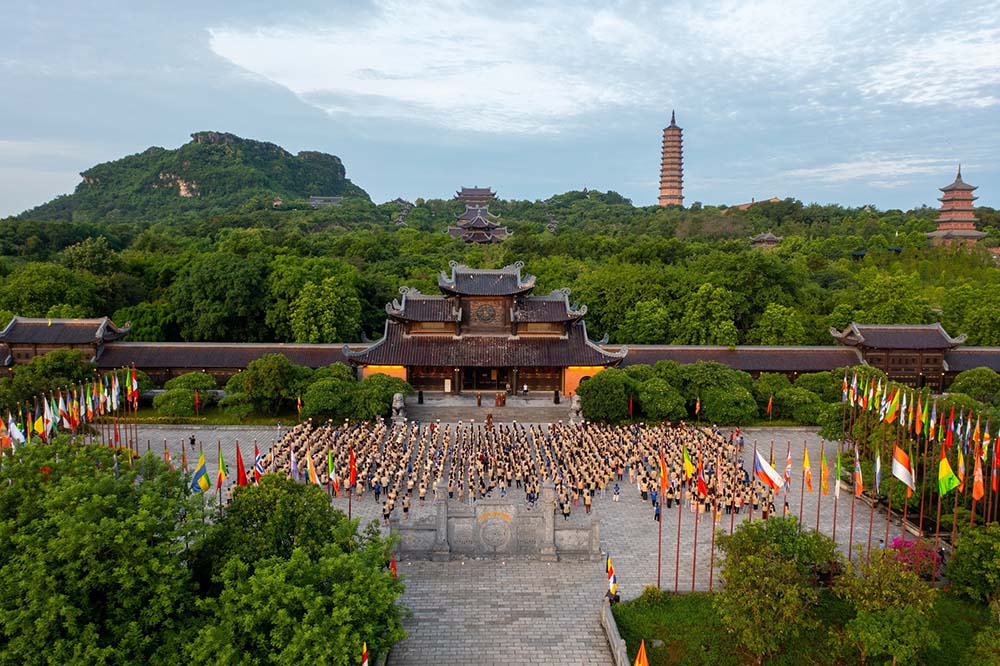
Bai Dinh Pagoda complex
-
Whereabouts: Ninh Binh - Gia Sinh Commune, Gia Vien District
-
Opening time: From 6 AM to 10 PM (Monday - Sunday)
-
Fees:
-
Entrance fee: Free
-
Electric car (if you choose): 30,000 VND/pax/round (about 1,3 USD)
-
Bell Tower ticket: 50,000 VND/pax (about 2,1 USD)
The pagoda complex features traditional-style temples, bell towers, and gates alongside record-breaking structures such as the largest golden Buddha statue in Asia, the longest corridor of Arhat statues in Asia, a 36-meter-tall bronze Buddha statue, a 100-ton bronze bell, and more.
Visitors are encouraged to come and explore this sacred site, as it offers stunning views of the surrounding limestone mountains and countryside. Bai Dinh is accessible to other famous tourist sites in Ninh Binh such as the UNESCO complex of Trang An, Cuc Phuong National Park, and the ancient capital of Hoa Lu. Bai Dinh Pagoda is also known for its annual festivals, which takes place during the Lunar New Year and attracts thousands of pilgrims from all over Vietnam.
Planning for first trip to Vietnam? Explore our guide for more insight!
Linh Ung Temple in Da Nang
Linh Ung is a Vietnam temple you must visit in the coastal city of Da Nang. The temple complex is situated on a hill overlooking the vast ocean, offering breathtaking views of the city, coastline, beach and sky.
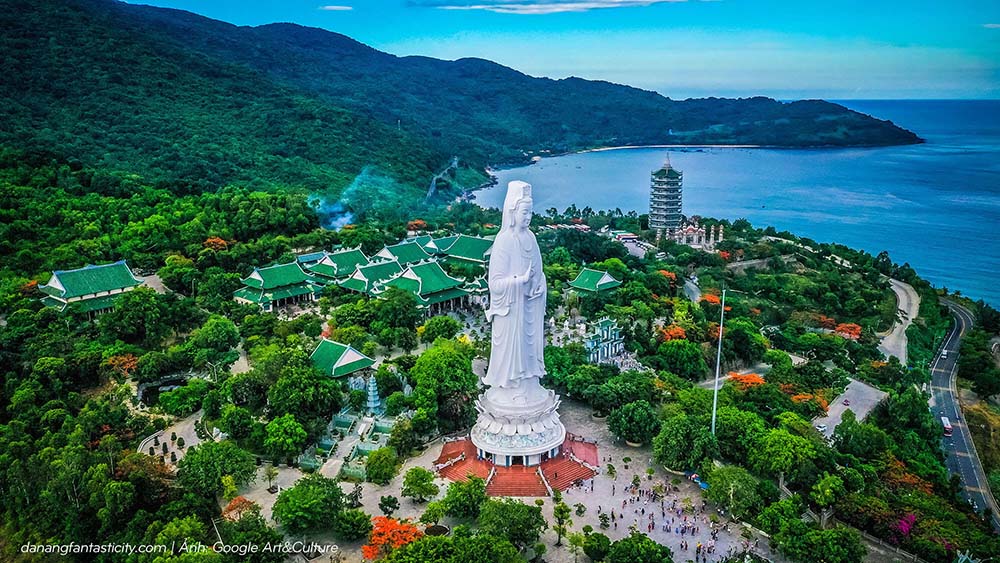
The Giant Lady Buddha standing in front of the sea
-
Whereabouts: Da Nang - Lam Ty Ni Garden, Hoang Sa, Tho Quang Ward, Son Tra Peninsula
-
Opening time: All days and times in the week
-
Entrance fee: Free
The element that makes this Vietnam temple stand out is Vietnam’s tallest Giant Lady Buddha statue dominating the sky. The statue is located on a hill over 100m high. It has an overall height of 67m, equivalent to a 17-floor building. The statue stands on the mountain, facing the sea, symbolizing the locals' wish for peace and prosperity amidst the waves of storms and winds.
This Vietnam temple is located on Son Tra Peninsula, which boasts a rich natural ecosystem and many other famous worth-visiting destinations such as Marble Mountains, the Giant Chessboard, Heliport Vestige and Army Radar Station. These attractions will provide you with a wonderful experience during your time in Da Nang.
Vinh Trang Pagoda in Tien Giang
Vinh Trang Pagoda was founded in the mid-19th century. The Vietnam temple is located in the Mekong Delta province of Tien Giang. Vinh Trang Pagoda is built in a mixed architectural style that combines various Asian and European architectural elements such as Vietnam, French, Roman, Thai, Burmese, and Cham.
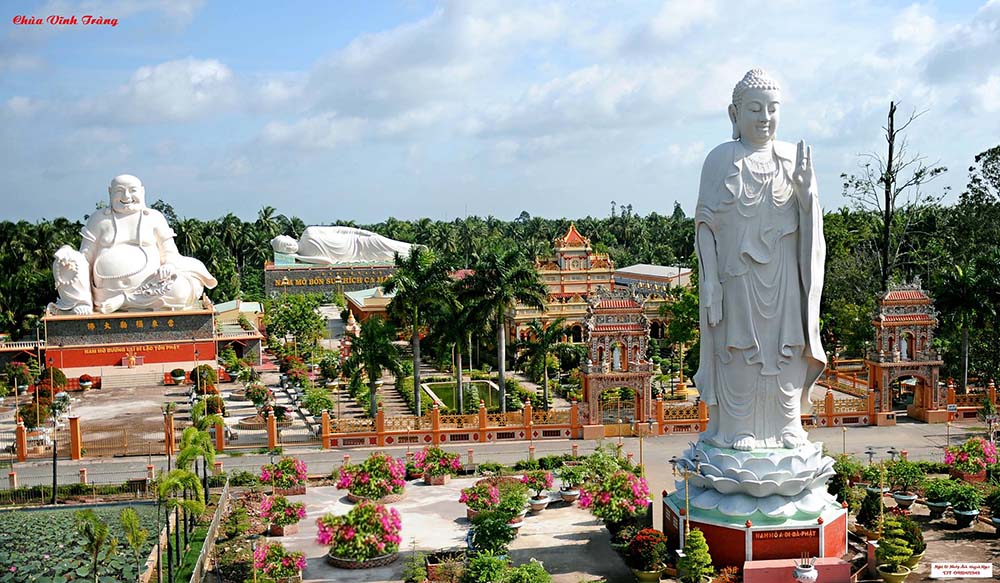
Vinh Trang Pagoda - Mekong Delta
-
Whereabouts: Tien Giang - My An, My Phong, My Tho
-
Opening time: From 6:30 AM - 6:30 PM (Monday - Sunday)
-
Entrance fee: Free
The Vietnam temple boasts of intricately carved embellishments and stunning mosaics. Aside from its one-of-a-kind architecture, the outstanding features of the temple include a Seven-storeyed stupa, a sculpture of Sakyamuni Buddha entering Nirvana, a 24-meter-tall statue of Amitabha Buddha, and a courtyard displaying a statue of the 20m Laughing Buddha. Visitors may also wander around the peaceful gardens and the elaborate shrines scattered throughout the temple compound.
Vinh Trang Pagoda is a must-visit when coming to the Mekong Delta area in Southern Vietnam. The Vietnam temple hosts several important festivals and events throughout the year, such as the Lunar New Year and the Mid-Autumn Festival, which are great opportunities to witness traditional Vietnamese customs and rituals.
The Thien Hau Pagoda in Saigon (Ho Chi Minh City)
The 260-year-old Thien Hau temple is known as one of the oldest Chinese temples in Saigon. It has become a significant spiritual destination of the city. The temple is dedicated to the Holy Lady Thien Hau, worshiped by the Hoa community (Chinese people from Guangdong, China immigrate to Vietnam) in Ho Chi Minh city to express their gratitude for safely arriving in Vietnam.

The impressive look of Thien Hau Temple
-
Whereabouts: Ho Chi Minh City (Saigon) - 710 Nguyen Trai Street, District 5
-
Opening time: 6 AM - 11:30 AM and 1 PM - 4:30 PM (Monday - Sunday)
-
Entrance ticket: Free
Hoa people believe that with the Holy Lady Thien Hau divine spirit's support, they can overcome obstacles and settle down peacefully. When the Chinese immigrants came to Vietnam, the belief in Holy Lady Thien Hau also spread, leading to the construction of many temples.
Visitors to this Vietnam temple can immerse themselves in traditional Chinese decorations and architecture, including intricate wood carvings and statues of dragons. Despite being located in the bustling heart of Ho Chi Minh City, Thien Hau Pagoda offers visitors a peaceful escape from the chaos of the city.
Tips for Visiting Vietnam Temples
What to wear and bring
It is important to dress modestly and respectfully as Vietnam temples are places of worship. Here we have some suggestions for you to keep in mind about:
-
Cover your shoulders and knees. Avoid wearing tank tops, crop tops, shorts, or skirts above the knee.
-
Loose-fitting pants or long skirts are ideal.
-
Wear comfortable shoes as you will need to remove them before entering the temples and pagodas.
-
Bring a cover-up or light scarf to wrap around your shoulders if you wear a sleeveless top.
-
Avoid wearing hats or sunglasses as you will need to remove them before entering the temples and pagodas.
Things you might need during your visit to a Vietnam temple
-
A bottle of water to stay hydrated in the hot and humid weather. However, remember to avoid eating and drinking inside the temple.
-
Some temples and pagodas might require an entrance fee, so bring some cash with you.
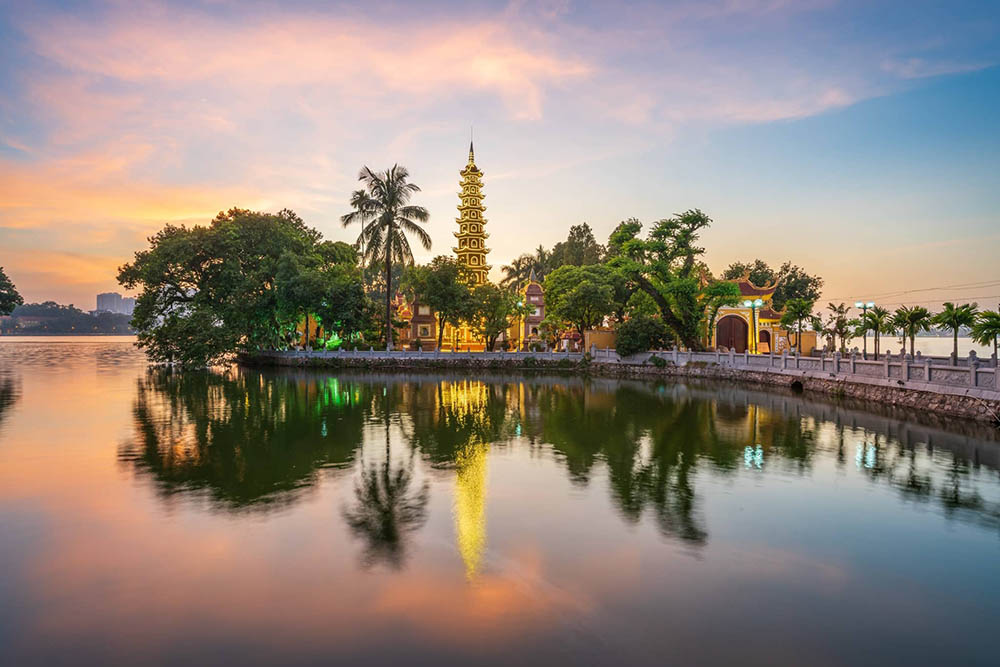
Tran Quoc Pagoda
How to behave and interact with locals and monks in Vietnam temples
-
When you go inside a temple, be quiet and respectful. Avoid talking loudly or making noise.
-
Follow the customs: Each Vietnam temple may have different customs, so pay attention to what others are doing and follow suit.
-
If you see a monk, you can show respect by bowing.
-
Taking pictures inside the temple is usually not allowed. If you are not sure, ask for permission first.
By following these tips, you can show respect to the locals and monks and enjoy your time while visiting Vietnam temples.
Best time to visit the Vietnam temple for a quiet and introspective experience
-
During off-season months: typically between May and September. It is because most visitors come during the peak tourist season and Lunar New Year, which includes the months of October to April.
-
Additionally, visiting the Vietnam temple on weekdays can provide a more peaceful experience as there are few people around. You can consider researching specific temples and pagodas to find out if there are certain times or days when they are less busy.
Recap
Now you know about the 9 best temples to visit in Vietnam as NewAsiaTravel recommends. These Vietnam temples are located widely throughout the country, built in different eras and on different cultural lands, but all represent the long-standing religious traditions of Vietnam. If you want to explore and discover more about Vietnam wonders, get in touch with us and share your ideas!



